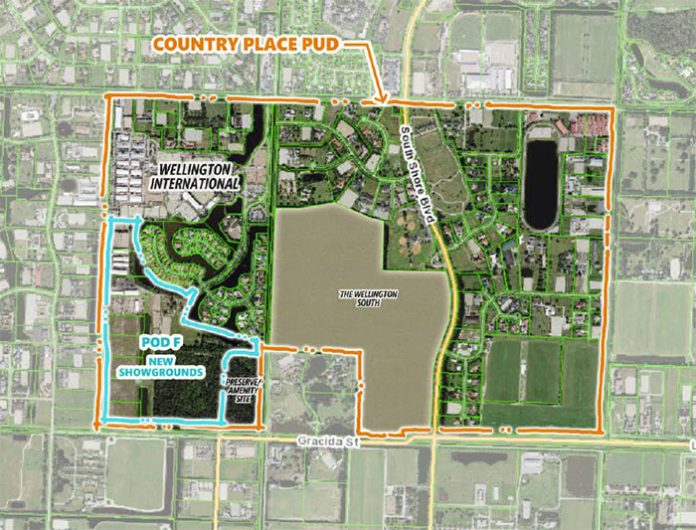The Wellington Village Council this week approved a massive makeover of the village’s signature equestrian showgrounds, enshrining some conditions and discarding others when builders argued they did not make economic sense or came up at the last minute.
Meeting Tuesday, March 5, the council approved the showgrounds expansion plan 4-0, with Councilwoman Tanya Siskind absent. It marked a pivotal moment in efforts to see if the village can build-in sufficient guardrails to ensure that an expanded, rejuvenated show comes to pass.
A better showgrounds is the central promised benefit for allowing a golf community on nearby land, including 96 acres that will be removed from Wellington’s Equestrian Preserve Area.
The council chose not to push every possible option. For example, it did not back a recommendation from the village’s advisory Equestrian Preserve Committee to double the number of permanent stalls on the new showgrounds to 440. Applicants working with equestrian entrepreneur Mark Bellissimo contended that was not needed and unduly expensive.
The plan already has an abundance of safeguards and assurances, proponents said.
“Tonight really is about Wellington’s future,” said Doug McMahon, CEO and managing partner of Wellington Lifestyle Partners, the development group behind the proposal. “Everyone wants the showgrounds to grow and thrive.”
Builders did agree to some requests from the equestrian committee, such as starting schooling hours at 6:30 a.m., minimum spacing of 25 feet between competition rings, and removal of language saying an arena could be built on a property adjacent to the one proposed, noted Paige Bellissimo Nunez, executive vice president at Wellington Lifestyle Partners.
The struggle, as council members saw it, came down to weighing ideas designed to increase the odds that rosy projections for the show really happen without piling too much on top of requirements already worked out.
“I think we want to make sure when we’re getting pitched a world-class horse show, that we’re getting all the pieces of a world-class horse show,” Vice Mayor Michael Napoleone said.
Even as it neared passage, the plan still faced skeptics among residents, such as Pam Wildman, who spoke at the meeting.
“These people don’t care about Wellington,” she said. “They want to make money.”
After the vote, Mayor Anne Gerwig said, “People can disagree, and only time will tell.”
Councilman John McGovern added that the process produced a better product than the one first proposed. “All of the people and boards involved made it a better plan,” he said.
The developers note that they have plenty of incentives to make sure a larger, reconfigured horse show comes about by the end of 2028, because if not, they can’t build houses on the land coming out of the preserve currently known as Equestrian Village.
Dressage, which now operates at the separate Equestrian Village location, would join hunters and jumpers at a consolidated Wellington International site, expanded into land known as Pod F, at the northeast corner of Gene Mische Way and Gracida Street.
The approvals allow an 84,000-square-foot covered arena, a 3,000-seat international arena, a 1,500-seat hospitality area, a 210-seat restaurant, a derby field and 5,100 square feet of retail operations, among other things, according to a village staff summary.
In plans dubbed Wellington North and Wellington South, builders earlier won approval, conditioned on horse show improvements, for 203 luxury homes and a commercial main street with a hotel, restaurants and shops.
At the March 5 meeting, representatives for neighbors of the prospective showgrounds in Equestrian Club Estates made a case for holding up the plan until agreements came into clearer focus for handling security issues. Specifically, they sought assurances that show operators will take concrete steps to ensure that transient visitors don’t wind up in their neighborhood.
McMahon said that issue came up only recently and “doesn’t represent the spirit of how we’ve been working the last three or four weeks.”
Village Attorney Laurie Cohen recommended against any conditions that gave neighbors an effective veto over the plan. Council members discussed it but, in the end, did not incorporate such a condition.
Another topic concerned possible requirements for mats, intended as comfortable flooring for horses in stalls or passageways. In spaces that do not already have mats, they will be available for rent or sale as owners choose, said Michael Stone, president of Wellington International. Requiring mats more broadly builds in higher fixed costs that all participants have to pay, hurting engagement with a segment of riders who do not have unlimited budgets, he said.
Another recommendation from the equestrian committee would have required that hospitality tents be on par with an existing media tent. Applicants said the problem with that is the media tent has glass siding, along with noisy air conditioning, factors that tend to make it harder for folks to see, hear and enjoy the show. They urged wording for “high quality” tents or pavilions, and council members agreed.
Some of the same issues came up in a review of the showgrounds expansion plan at Wellington’s Planning, Zoning & Adjustment Board meeting Wednesday, Feb. 28. There, Board Member Ron Herman asked if backers of the showgrounds proposal agreed with a recommendation from the Equestrian Preserve Committee to double the permanent stalls from 220.
“Is there a response?” Herman asked.
Nunez said the goal was to match or exceed the permanent stalls at the current dressage facility, which was 192. That was negotiated upward to 220 over time, she said.
“There’s no real need to build another 220 stalls, to have 440 permanent stalls that would probably not be used,” Stone said. “They’re not cheap.”
Typically, 50 or fewer temporary tent stalls are needed now, even for events with peak participation, he said.
Dressage riders tend to use such stalls less often than hunters and jumpers, with many preferring to haul in and out of specific events, Stone explained. More permanent stalls could be added in the future if needed, he said.
The PZA board approved the proposal on a 5-0 vote, sending it on to the council.








